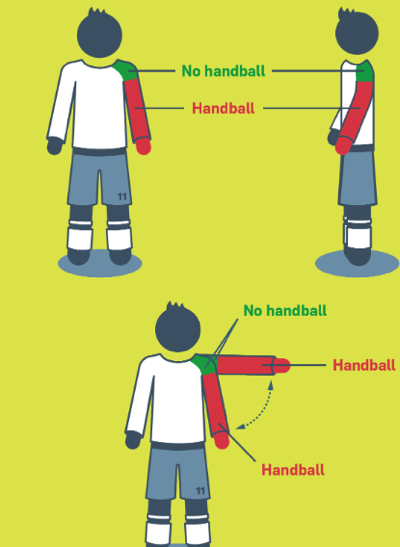When Ronseal (British wood stain manufacturer) came up with the advertising slogan ‘it does exactly what it says on the tin’, they probably didn’t realise they had invented a colloquialism that would enter lexicon as a way of describing something that is, erm, exactly as described. Football’s handball rule should be a sporting equivalent of Ronseal – if the ball hits a player’s hand then it’s handball, right?
Well, yes. Or, maybe no. It depends. As if that wasn’t mind-boggling enough, players can also be penalised for handball when the ball strikes their arm in a certain position. Confused? You should be. Let’s take a closer look at football’s handball rule to find out exactly what constitutes handball and which ‘ball to hand’ scenarios are overlooked.
What Is a Handball in Football?
 The International Football Association Board (IFAB) is tasked with coming up with the rules of football, and they have tried their best to make what should be an uncomplicated rule as nuanced and as complex as possible. Once upon a time, a handball offence was committed when a player deliberately blocked the ball with their hand or any part of their arm below the shoulder.
The International Football Association Board (IFAB) is tasked with coming up with the rules of football, and they have tried their best to make what should be an uncomplicated rule as nuanced and as complex as possible. Once upon a time, a handball offence was committed when a player deliberately blocked the ball with their hand or any part of their arm below the shoulder.
Nowadays, the handball rule has even more layers applied to it. If the ball touches a player’s hand/arm – even unintentionally – when their hand/arm has made their body ‘unnaturally bigger’ in an unnatural position, they will also be penalised.
A definition of that, as per IFAB, reads: ‘A player is considered to have made their body unnaturally bigger when the position of their hand/arm is not a consequence of, or justifiable by, the player’s body movement for that specific situation.’ This is often seen when a player thrusts their arms outwards when blocking a cross or trying to win an aerial duel.
Match officials are also far less likely to overlook accidental handball these days – particularly if the infringement leads to a goal being scored. A free kick will be awarded for handball, or a penalty if the infraction takes place inside the 18-yard box. A player can be cautioned or even sent off for deliberate acts of handball, too.
What Constitutes Handball?
So we know what handball is given for, but what part of the arm does it refer to? The hand, of course, is a given, while new guidelines from IFAB to match officials confirm that the ‘t-shirt rule’ should be applied – if the ball hits the arm below where the shirt of a t-shirt would fall, then it’s considered handball. There’s a handy visual aid on the Football Association website:

Football’s handball rule should be completely simple in its understanding and implementation, but the sport’s officiators have come up with t-shirt lines and ‘unnaturally big bodies’ to make the most basic of laws unnecessarily complicated.
Handball vs Ball to Hand
Even though match officials are watching for handball like a hawk, there are some instances in which they will let an incident pass by. When the ball strikes the hand/arm of a player unintentionally and they are in a ‘natural’ position that doesn’t make their body bigger, i.e. their arm flat to their side, then it will likely be decreed as ‘ball to hand’ – from which play will continue without punishment.
In other instances, a player will be struck by a ball travelling at such speed that they simply won’t be able to move their hand/arm out of the way in time – again, this is construed as ball to hand. Other times, a player may put their hand down to break their fall, if they are performing a sliding tackle for example. In this case, they will likely be cut some slack if the ball does strike them on the hand or arm.
Can a Goalkeeper Handle the Ball?
As you probably know, the goalkeeper is the only player on a football pitch that is allowed to handle the ball. But even then there’s caveats. They are only allowed to handle the ball inside their own penalty area – if they advance outside of the box and touch the ball with hand or arm, a free kick will be given and the keeper is liable to be yellow cared or worse.
Even in certain cases inside of their box, they could be penalised for picking up the ball. The back pass rule, introduced in the 1990s, made it an infringement for a goalkeeper to pick up the ball when it was passed to them by a teammate – unless they had headed it back to them.
It doesn’t happen very often these days, but there’s some legendary clips of indirect free kicks being awarded against a goalkeeper inside the penalty area in days of yore – with defenders tasked with blocking the resulting shot being powered at them from a matter of yards away.
A goalkeeper also cannot drop the ball at their feet and then pick it up again – this is effectively handball, and an indirect free kick will be awarded to the opposition. Another player on the field must touch the ball before the keeper is allowed to handle it again.

